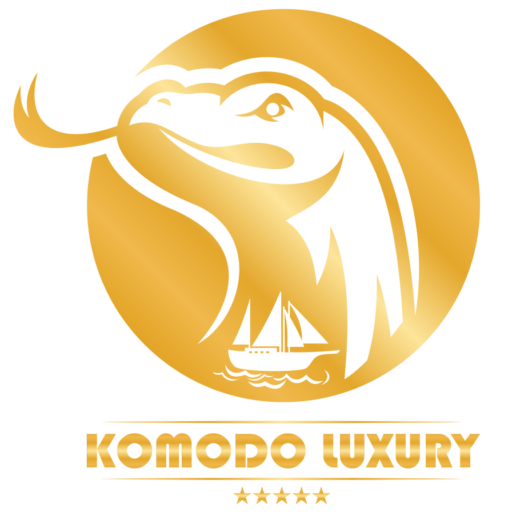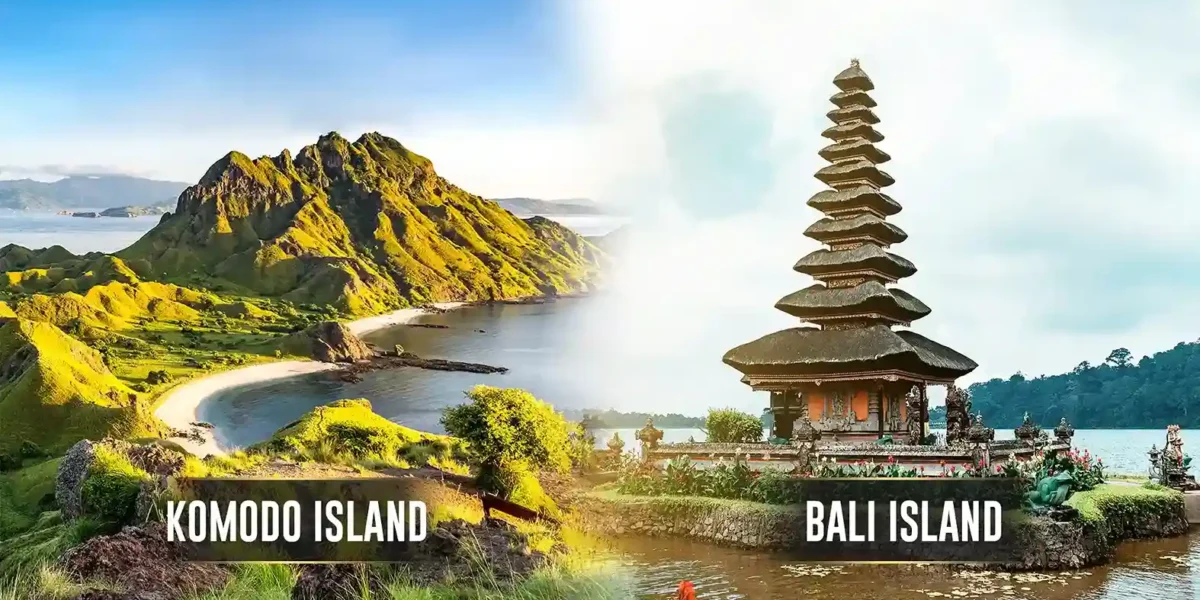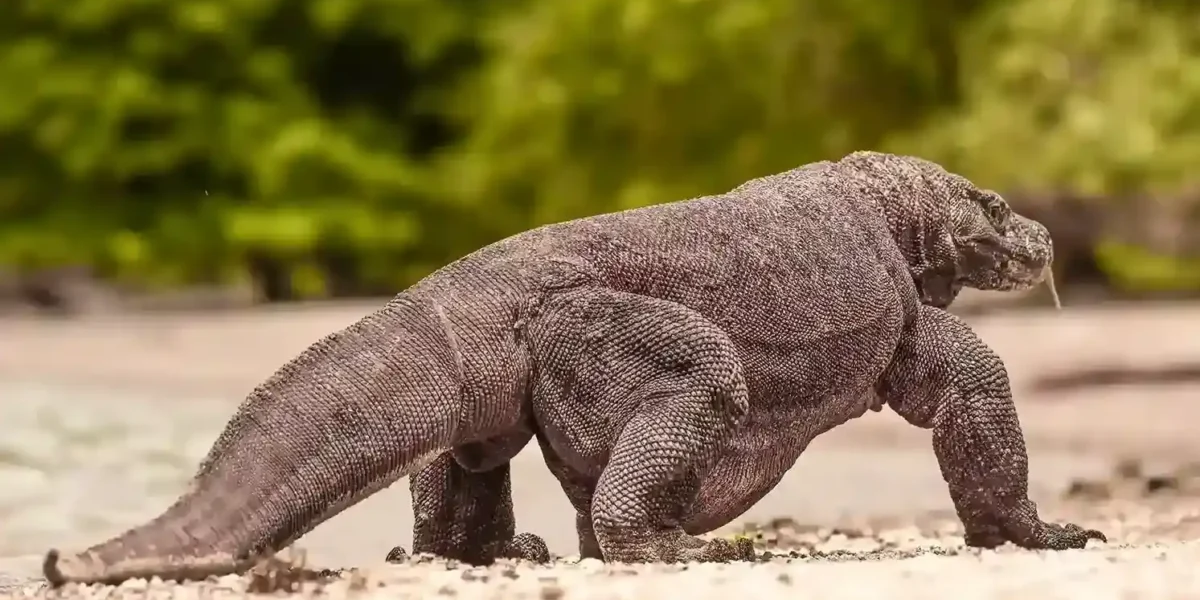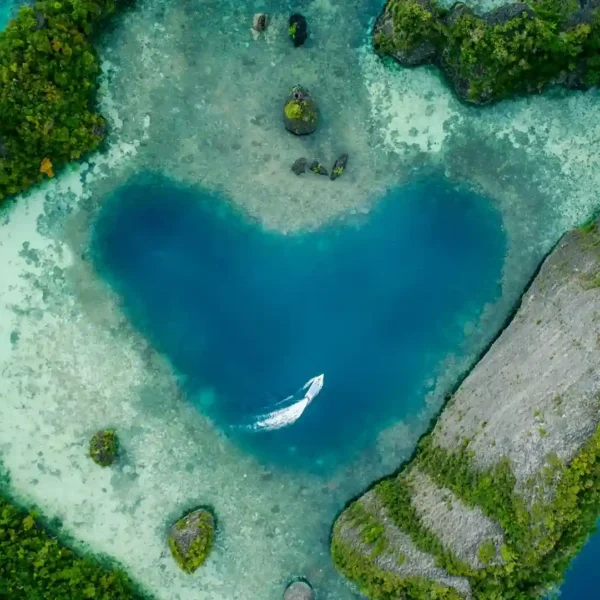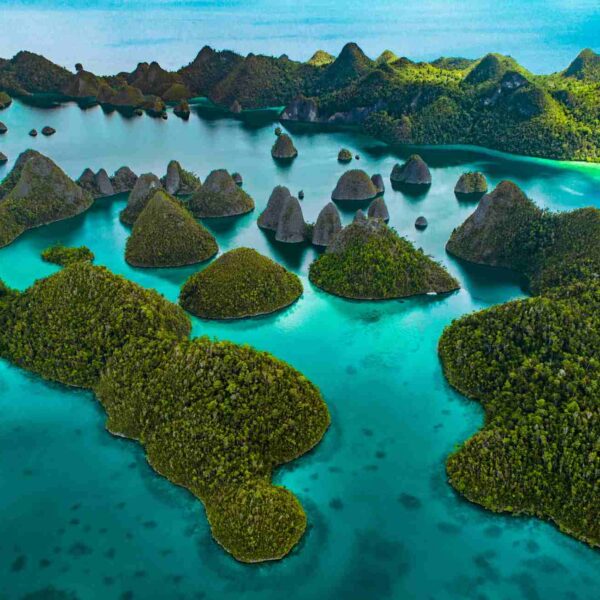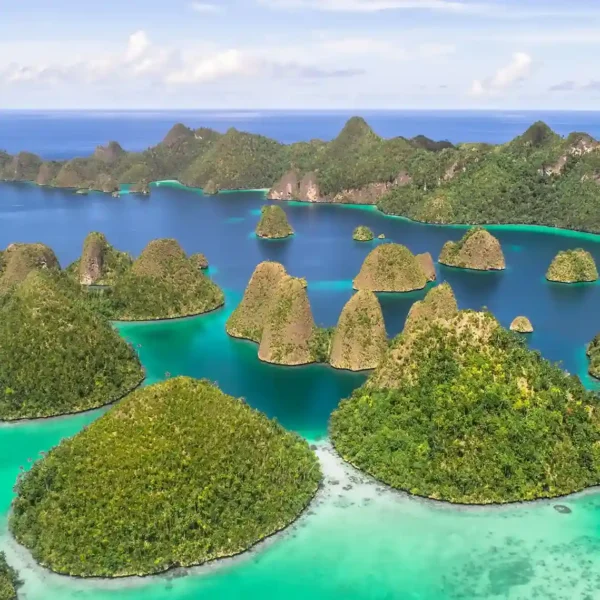Visiting Komodo National Park requires careful planning, as it’s quite a journey to reach. Not only will you have the chance to encounter the world’s largest lizard, the Komodo dragon, but you’ll also enjoy its stunning natural scenery while sailing on a luxurious boat. In this guide, we’ve gathered all the essential details of a Komodo boat tour to ensure you have a comfortable and memorable trip with Komodo Luxury.
Getting Ready for The Trip: Things to Know
Before you start your adventure with Komodo Luxury, here are some things you should know:
Does the Trip Include Tickets, Rangers, and Local Guides?
The package from Komodo Luxury doesn’t include the entrance fee to Komodo National Park. You need to pay the entrance fee with the following conditions (updated April 2024):
- IDR400,000/person for Indonesian citizens.
- IDR700,000/person for foreigners.
- Free for children aged 0-2
- Half price for children aged 3-4
- Full price for children over 5
- Drone flight permit fee IDR1,100,000.
Note: Drones are not allowed to fly around Kalong Island and Rinca Island, as it is feared that they could negatively affect the wildlife in these areas.
These fees cover a ranger who will accompany you on Komodo Island or Rinca, as well as entrance fees to the destinations you’ll visit. Komodo Luxury also provides a local tour guide with over 9 years of experience, ready to help you explore the park’s beauty.
When Should I Arrive in Labuan Bajo
We recommend arriving in Labuan Bajo at least one day before your trip begins to prevent any delays due to flight issues or other unforeseen circumstances. This is particularly important for those joining group trips, as delays could affect other travelers.
If you are joining an Open/Share Trip package and plan to arrive on the same day the trip starts, you should aim to land at Komodo Airport no later than 09:10 WITA since the pick-up window is between 09:30 and 10:30 WITA. Remember, any delays and cancellations will be your responsibility. However, if you are joining a private trip, you have more flexibility with your arrival time. Try not to arrive too late in the afternoon, as you are expected to arrive at a maximum of 14.00 WITA.
Meeting Point and Pick-Up
The meeting point and pick-up are in the Labuan Bajo area. Our team will pick you up using a private car at the airport or at your hotel. From there, you will be transferred to KP3 Harbour, Labuan Bajo, to start your exploration of the beauty of Komodo National Park.
This arrangement ensures your safety and protects you from potential scams that can be occur when visiting the park without a trusted tour operator like Komodo Luxury.
Before Departure: Preparations
Visiting Komodo National Park involves a variety of physical activities, including trekking on Padar Island, swimming at Pink Beach, and snorkeling and diving near Kanawa Island. To prepare for your visit, please consider the following:
Check Your Physical Health
Activities in Komodo National Park demand excellent physical health. Ensure that you are in good health, especially if you are elderly or have chronic conditions such as heart disease, asthma, diabetes, GERD, rheumatism, or respiratory infections. Elderly travelers or those with health issues should be cautious about participating in strenuous activities like trekking or diving.
If you have any pre-existing medical conditions or food allergies, inform our team when you book so we can accommodate your needs during the trip. We recommend that travelers over 60 should only join the trip if they are physically fit and should be accompanied by someone who can assist them throughout the journey.
Physical Exercise
To best prepare for the physical demands of the trip, engage in regular exercises such as jogging or swimming at least a week before your departure. This will ensure you maintain a good fitness level, enabling you to participate comfortably in both light and more strenuous activities during your visit to the park.
During The Trip: What’s on Board
Your holiday to Komodo National Park will be a memorable one as you sail and stay aboard a luxurious boat, exploring the area’s natural beauty. Here are the amenities you can expect during the cruise.
Cabin Facilities
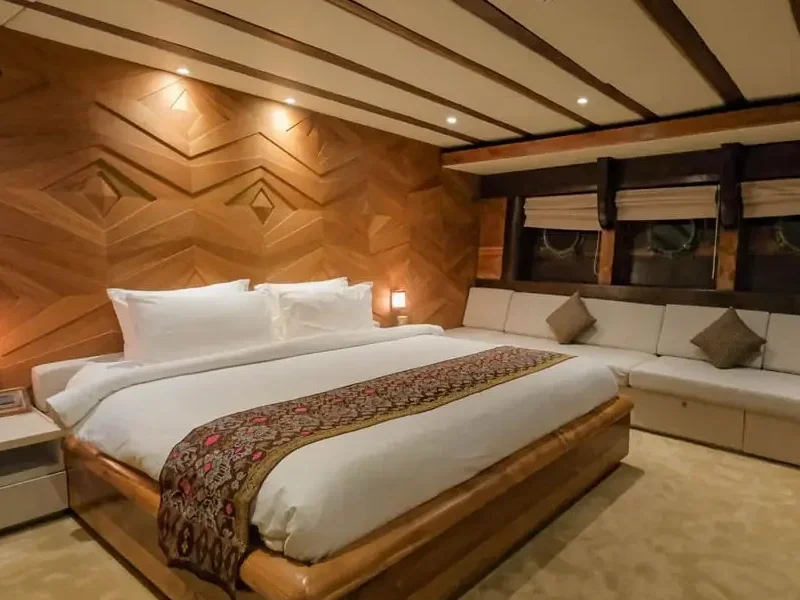
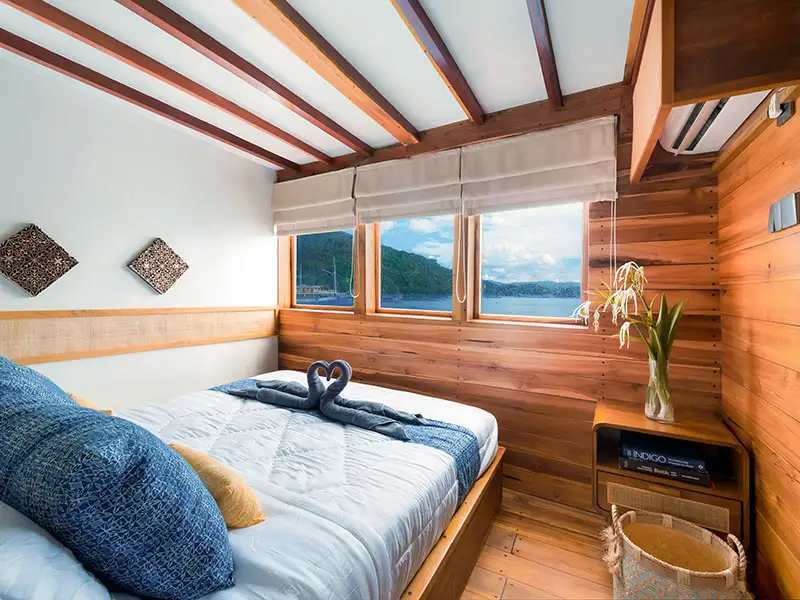
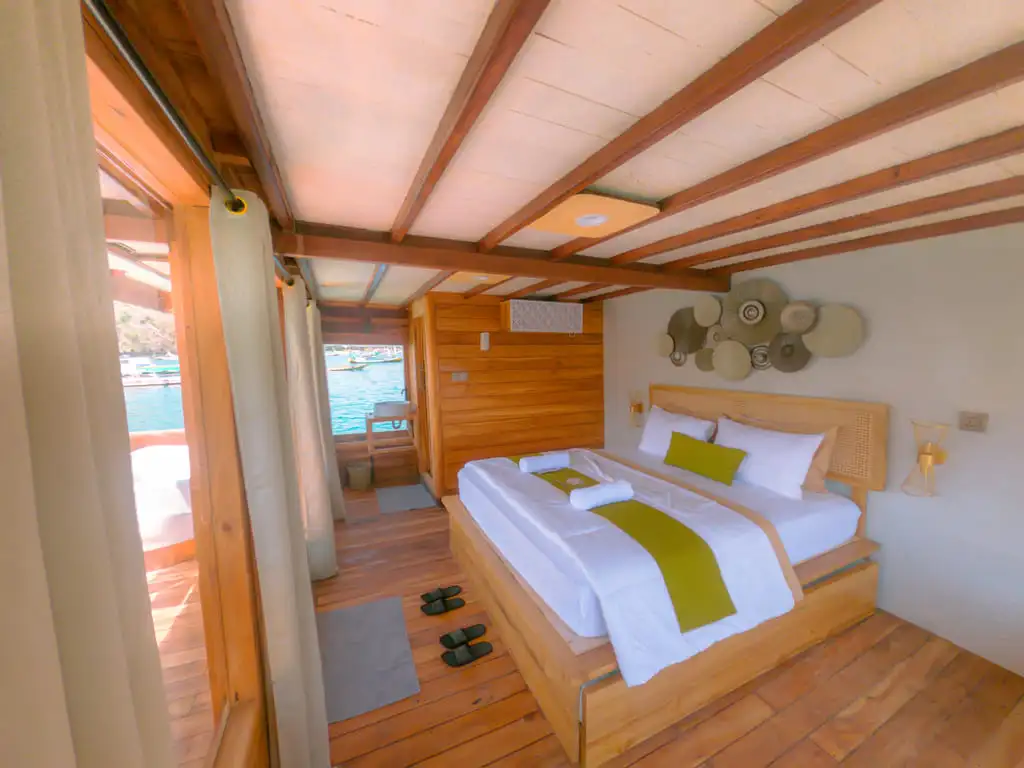
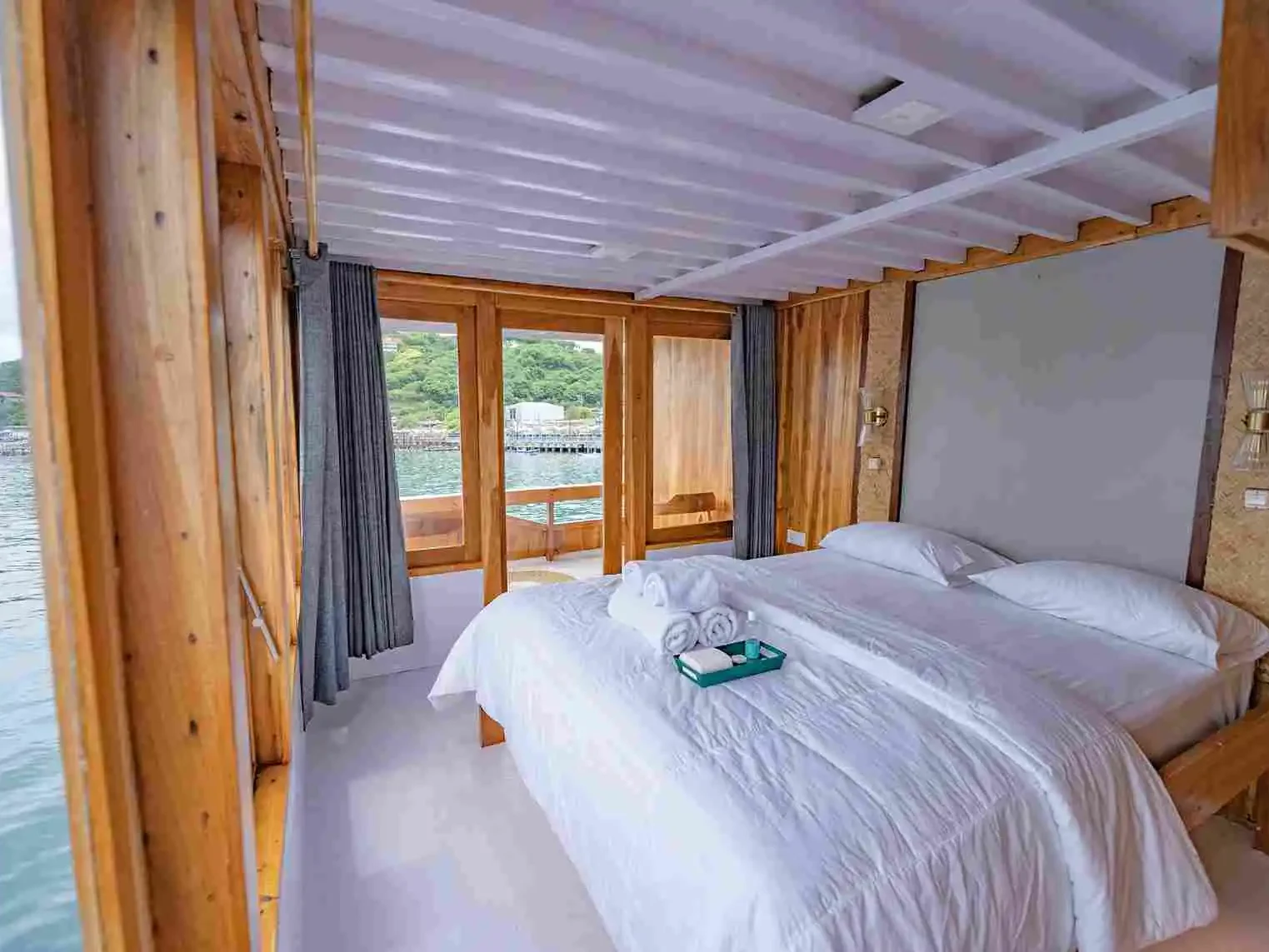
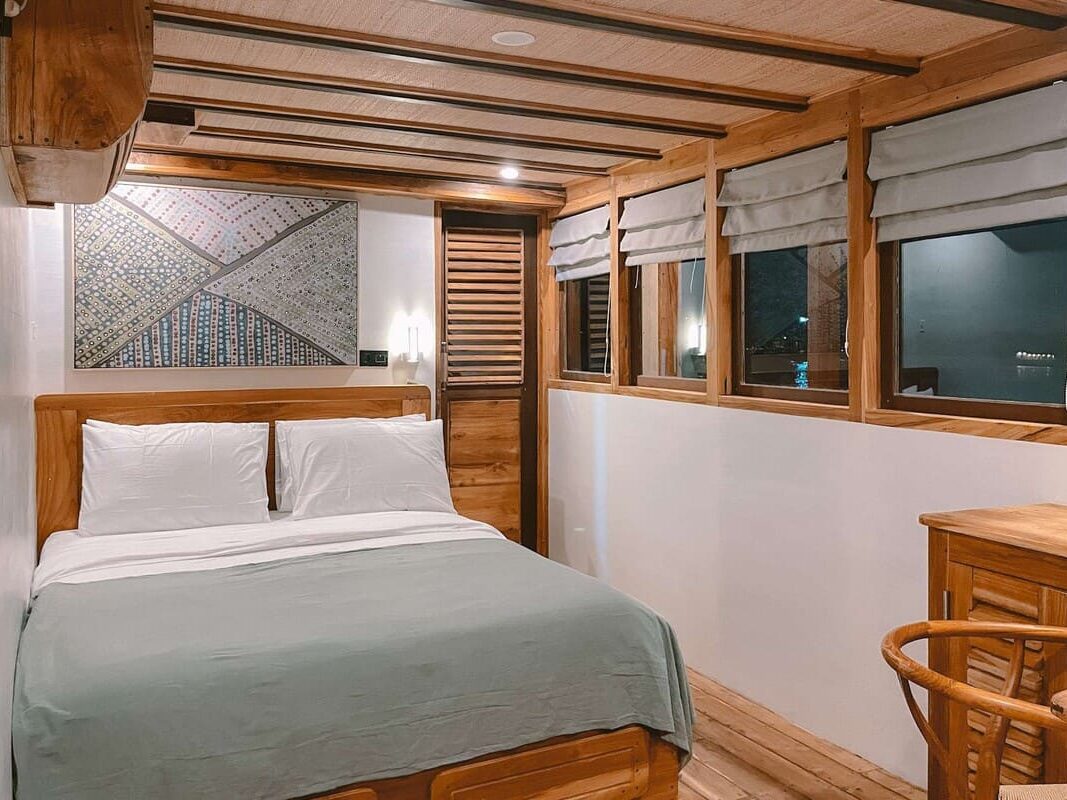
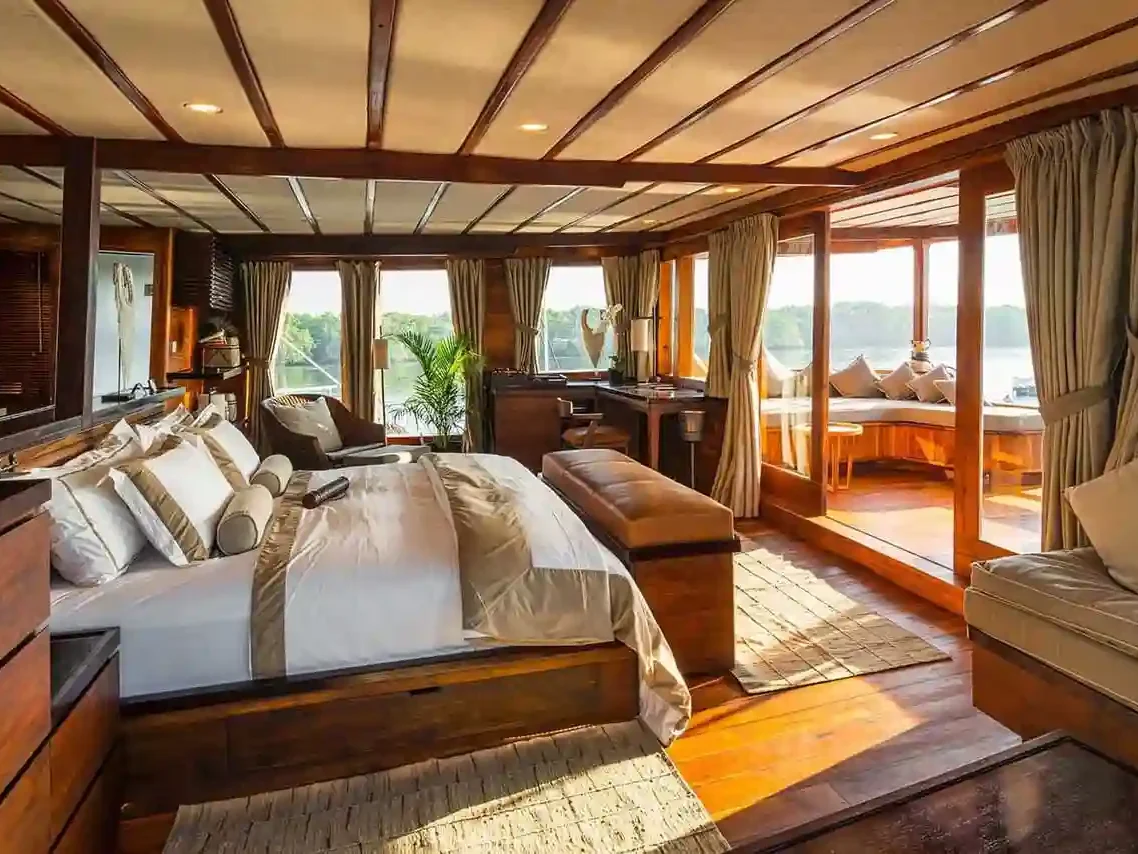
Your stay will be unlike any other, as you’ll be accommodated in a luxury cabin. Most cabins on the boat are fully equipped with amenities, including beds, blankets, wardrobes, air conditioning, and private bathrooms. If you are a backpacker opting for an open package, you may request a specific room when booking, although this is subject to availability and certain conditions.
Food and Beverages
While on the trip, professional chefs will serve you food. There is a variety of food available on board, including chicken, fish, meat, tofu, tempeh, vegetables, and fruits. Drinks include mineral water, coffee, and tea. If you’d like to drink alcohol, you are allowed to bring your own alcohol.
Note:
- If you have any food allergies, please inform our team during the booking process so we can customize your meals accordingly.
- The food and beverage menu may vary depending on the type of the boat you choose.
Toiletries
Toiletries such as shampoo, soap, and towels are provided on board. However, if you prefer to use your own, you are welcome to bring personal toiletries made from eco-friendly materials. It is also a good idea to bring an extra towel, as activities in Komodo National Park often involve water, and you might need a dry towel if the provided one is still wet.
Snorkeling and Diving Equipment
For those who enjoy snorkeling and diving, basic equipment is available on each boat. However, if you have your own gear, such as masks, you are encouraged to bring them as they will be more hygienic and better fitted, ensuring greater comfort during use. If you are traveling with children, you can request children’s snorkeling and diving equipment when you book.
Documentation
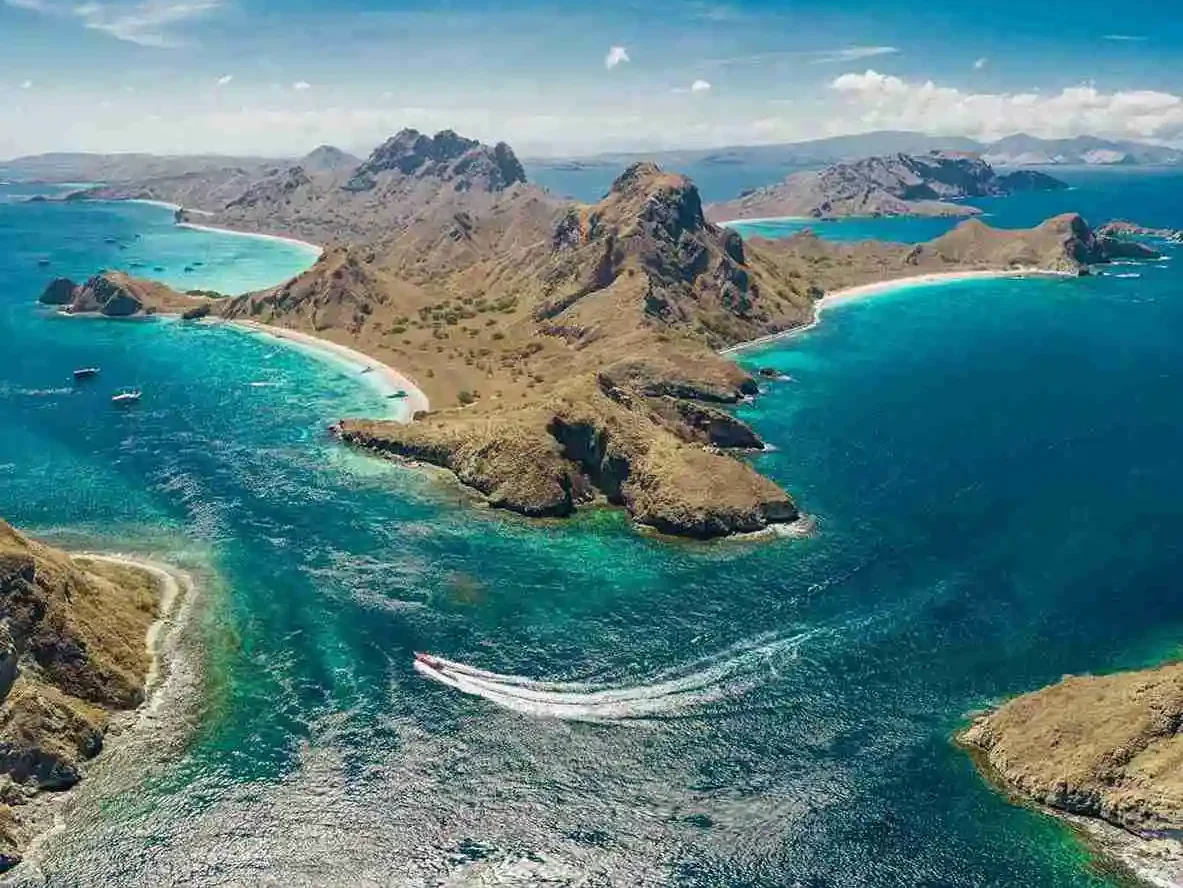
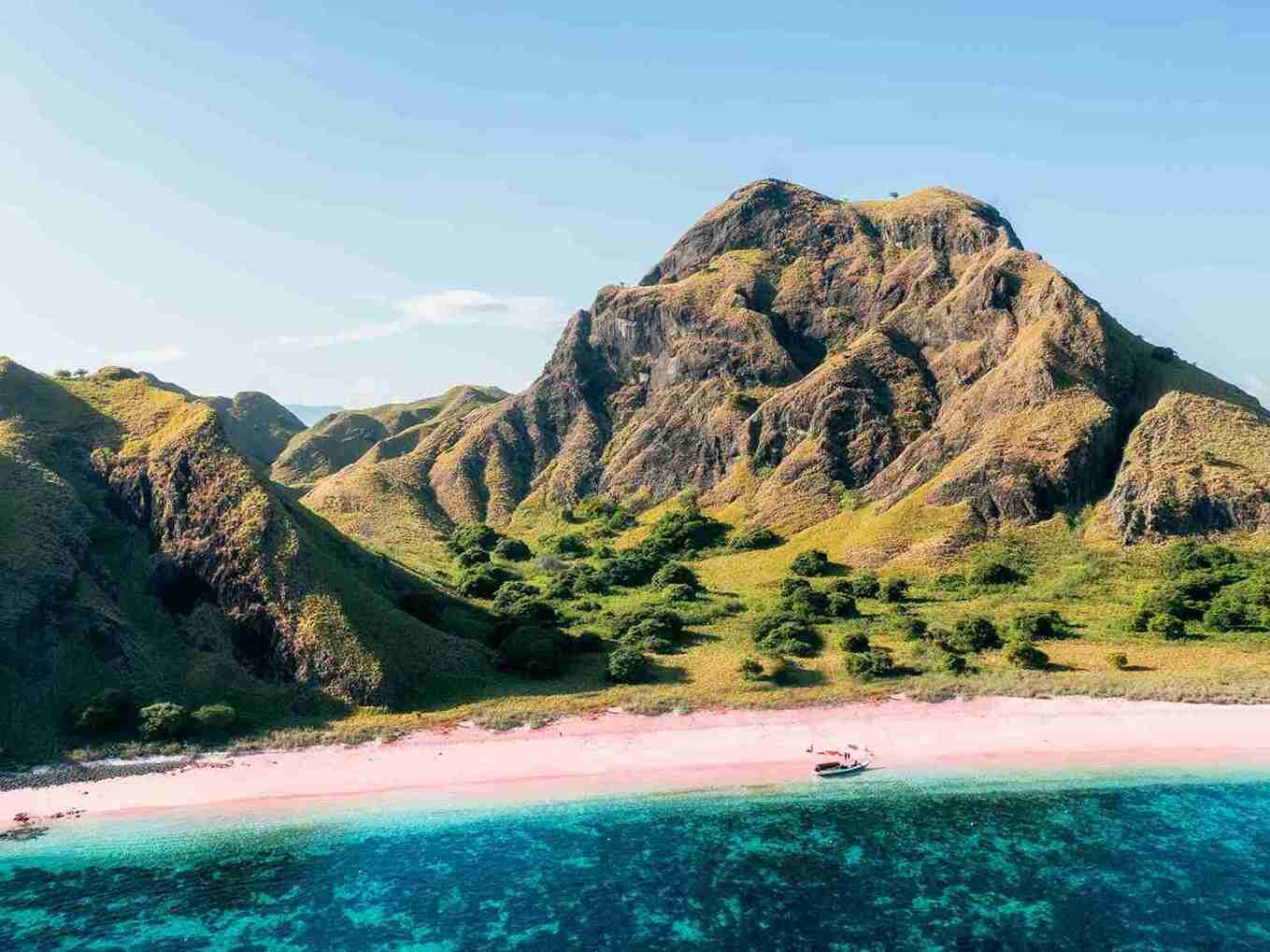
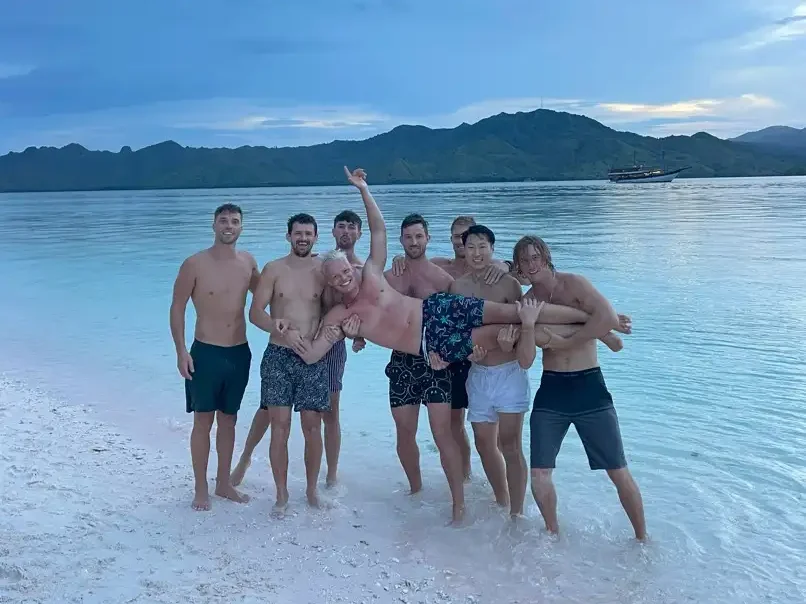

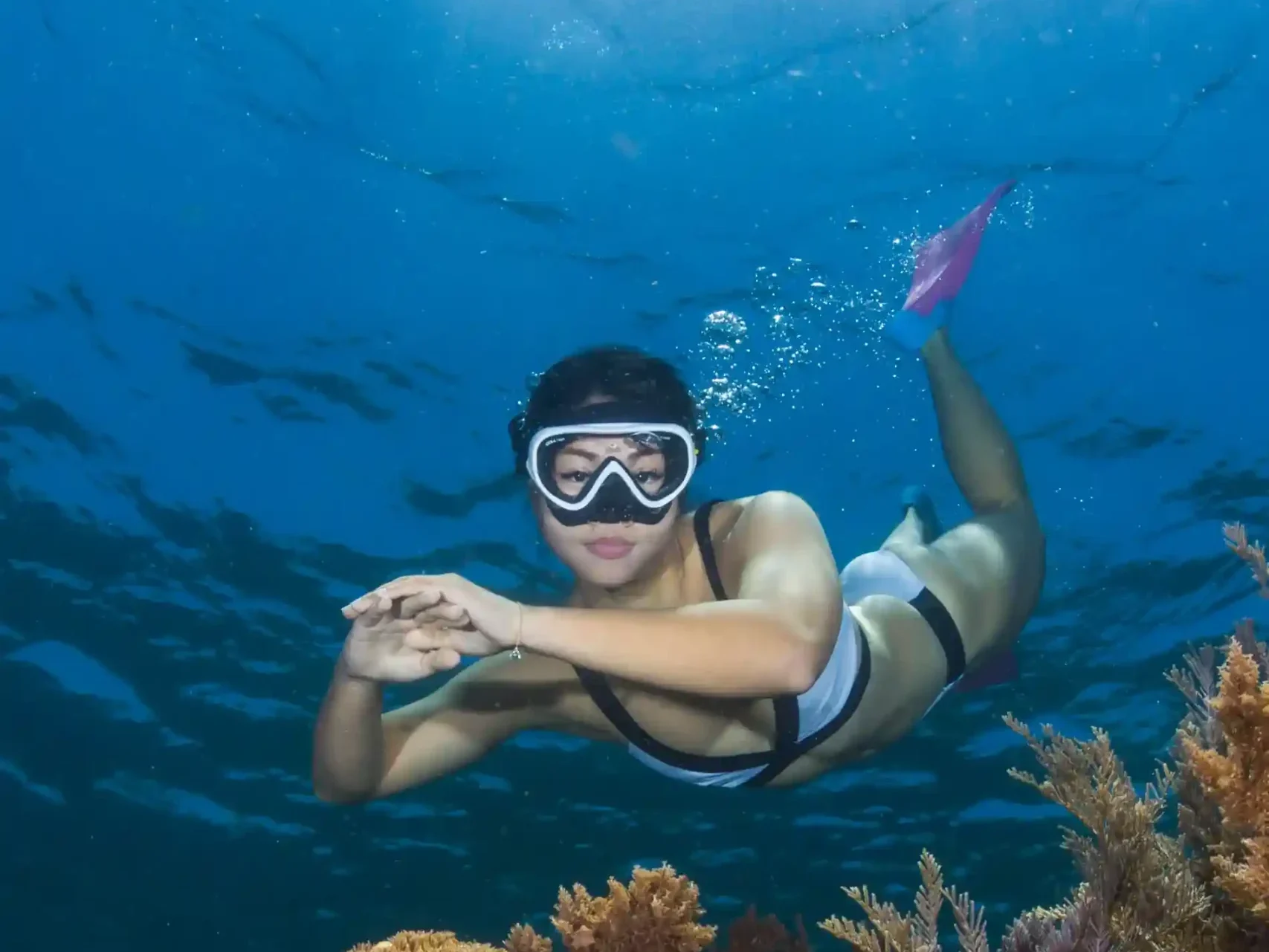
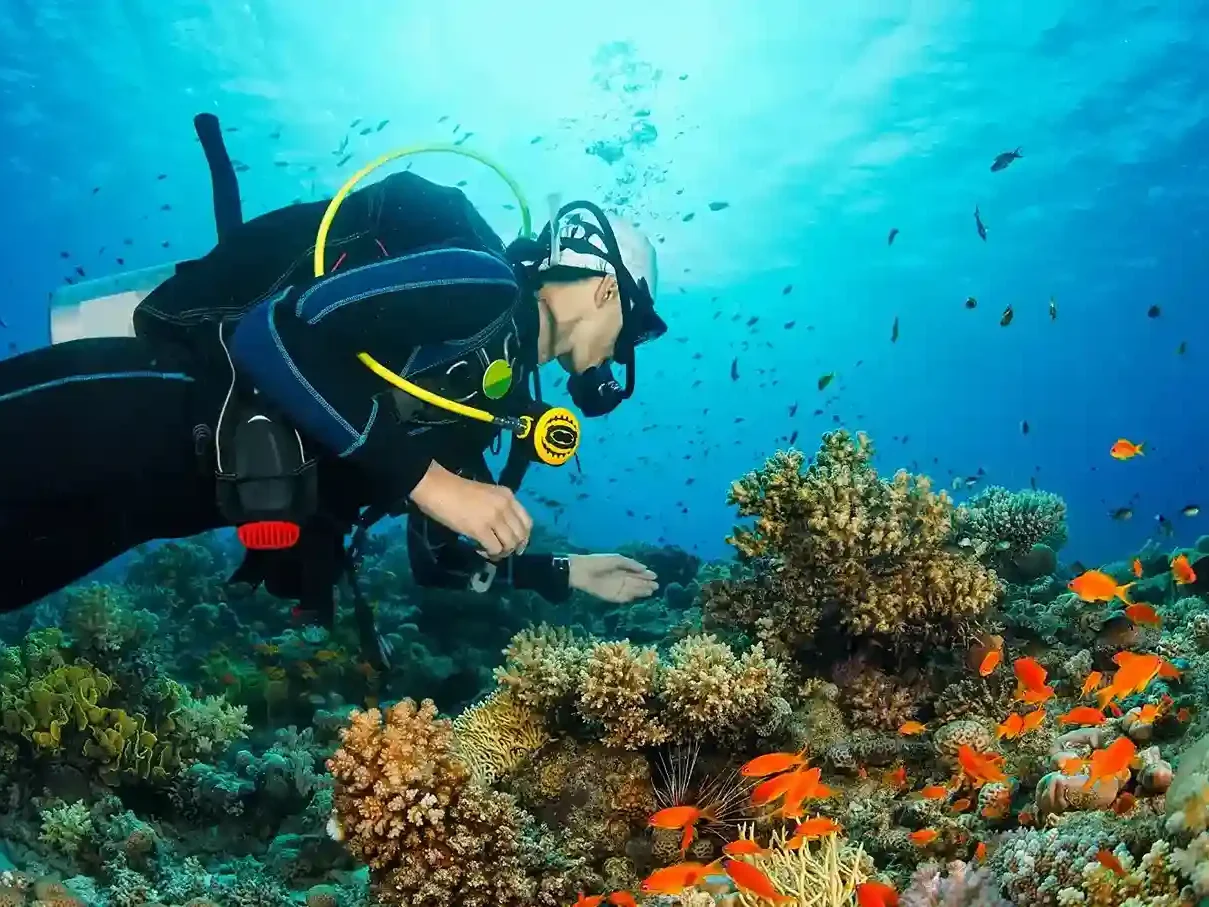
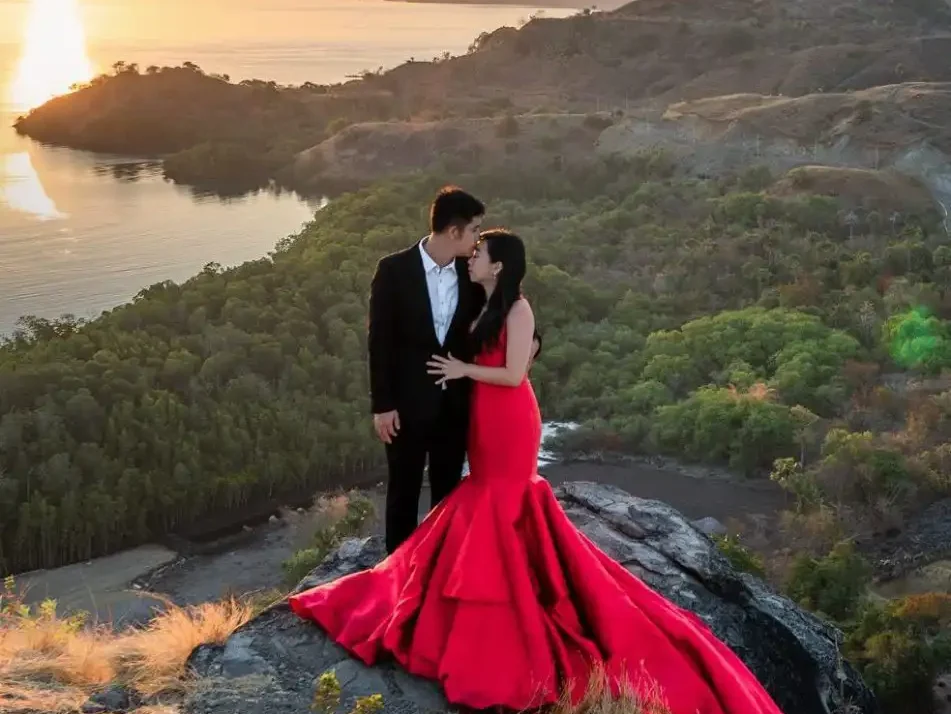
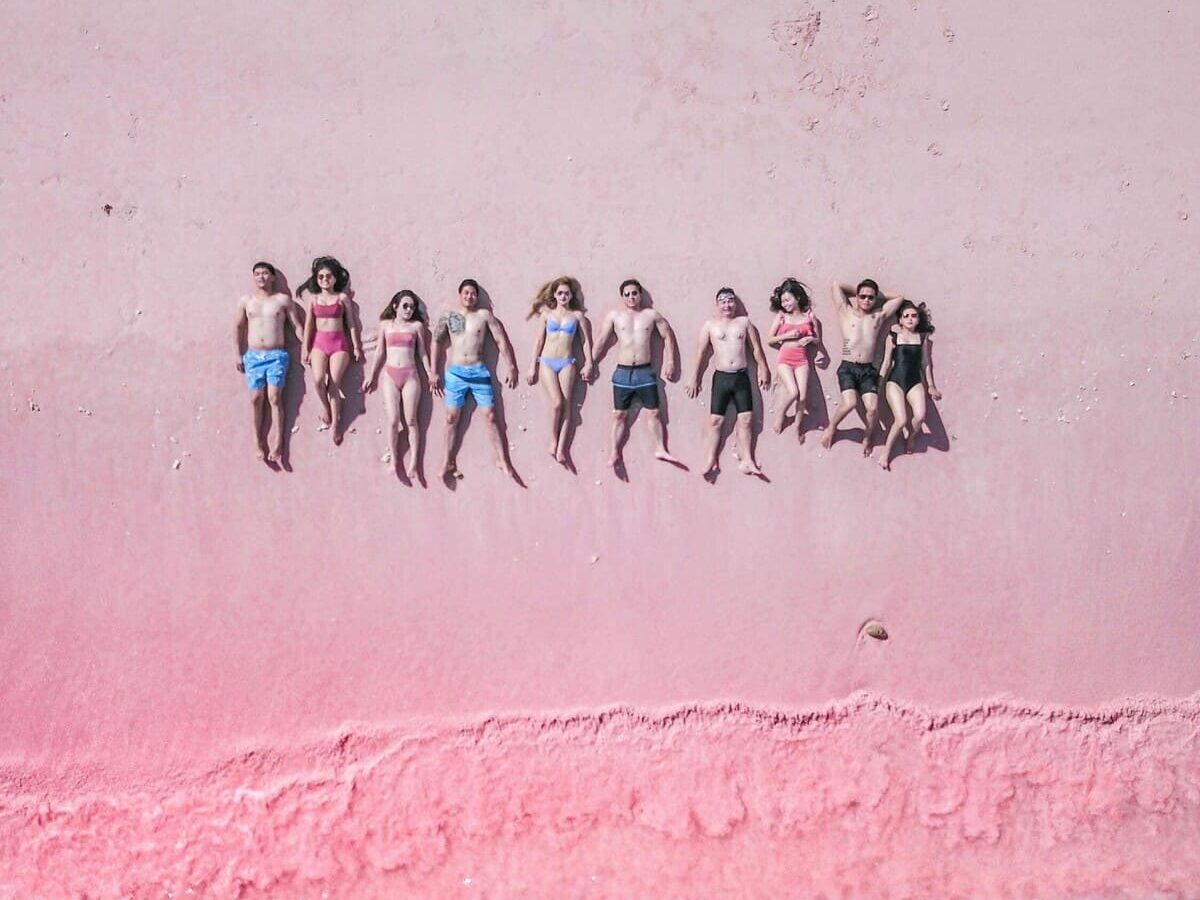
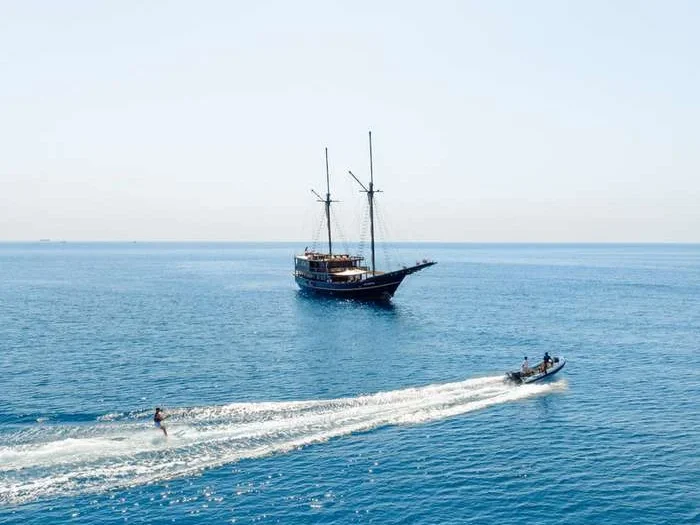
We provide unedited documentation for each 3D2N sailing trip on Komodo Island. Each traveler agrees to be recorded and photographed during the trip, and we reserve the right to use this footage and photos for promotional purposes on social media.
If you prefer not to have your images shared on the company’s social media, please inform your guide at the start of your trip.
Drones, cameras, and GoPros are usually used for this documentation. Tourists are advised to bring a hard drive with a capacity of 15-35 GB to store the documentation files, which will be provided in RAW format after the trip.
If you want special documentation with cameras and people who document more professionally, you can use the services of Labuan Bajo Production.
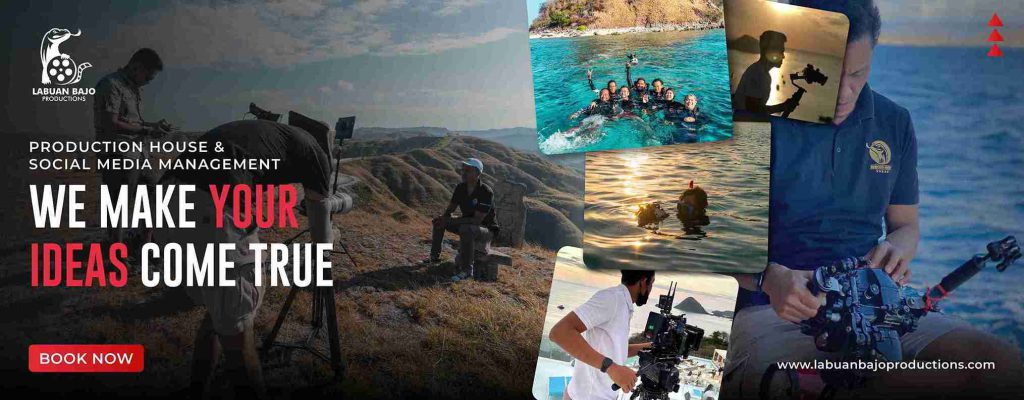
Things to Know While on The Boat
Is There a Signal on The Board?
Signal availability can vary. Some providers may offer intermittent service, but Telkomsel users generally receive a stable signal.
Does The Boat Have WiFi?
WiFi is available on certain boats, mostly for VIPs and VVIPs. You can confirm WiFi availability on your selected boat at the time of booking.
Is There Electricity?
The boat is equipped with electricity available 24 hours a day. You can use this to charge electronic device such as mobile phones and cameras.
Does The Cabin Have Air Conditioning?
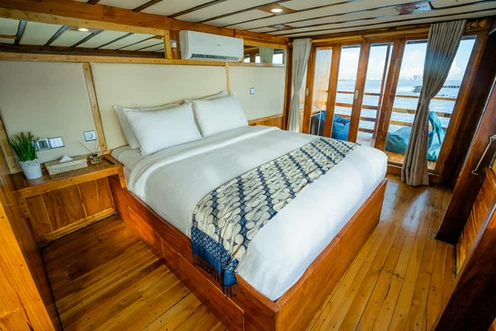
Yes, each cabin is equipped with air conditioning to ensure your comfort during the trip.
Is it Comfortable Staying in The Boat?
The sound of the boat’s engine will be heard while sailing, depending on the cabin position. However, the engine will turn off at night when the boat is not sailing, so you can still sleep peacefully. We recommend bringing a headset or earplugs to minimize noise disturbance during your journey.
Staying on a boat can be comfortable, particularly when sailing through the serene waters of Komodo National Park. You’ll likely spend much of your time outdoors or in the living room, enjoying the tranquil seascape that’s calm almost year-round. The beautiful views of Komodo National Park are a constant companion as you sail.
As for sleeping arrangements, the boat is designed with an always-on electric engine, while the main propulsion engine is turned off when not sailing. The level of noise from the electric engine depends on the type and layout of the boat, as well as the location of your cabin. Sometimes, the boat will sail while you sleep, but the noise is generally not too disruptive, allowing for comfortable sleep.
For those who are particularly sensitive to noise, it’s advisable to bring earplugs or headphones with noise cancellation to enjoy undisturbed sleep to the soothing sounds of chill music while sailing.
Is it Safe to Keep Valuables Items or Money in the Cabin?
If you’re on a private trip, you’ll have the entire boat to yourself. As part of our standard operating procedures, the boat crew will not enter your room except to clean it or for any other purpose with your permission.
It’s recommended to store cash and valuables such as electronic devices, jewelry, etc., in your cabin. If you choose to leave cash or valuables item in the cabin, please remember to lock the room when you’re away to ensure their safety and your peace of mind.
However, on an open trip, you’ll be joining other travelers. We suggest keeping your valuable items with you. Not all cabins are monitored by CCTV, so securing your belongings is important to avoid any potential issues.
What if an Emergency Occurs on the Boat?
What If You Get Sick During The Trip?
First aid kits are available on board, but we strongly advise each traveler always to bring their own medication. Let the guide or admin know if you have any pre-existing medical conditions so they can suggest activities that are less strenuous. It’s important not to push yourself to prevent any health issues.
However, if tourists are sick with severe conditions, we will take them back to Labuan Bajo or a nearby island with a health center using a speedboat. If the condition does not improve, they will be transferred to the nearest hospital.
What If There Are Big Waves or Bad Weather?
If problems arise due to unfavorable weather before the trip and the Harbourmaster issues a warning letter not to sail, the trip must be postponed (rescheduled), but there is no refund. Rescheduling provisions are valid for one year from the time the trip is rescheduled.
During the trip, if bad weather or large waves occur, the route will be modified, or a safe place in the will be found first before continuing the sailing trip. Mostly, the sail will be in the bay area where it safe.
17 Things to Bring to Komodo National Park

1. Identity Card
Identity cards are required to verify the details of the travelers who will be sailing as a safety precaution should anything untoward happen. The identity card is used as a requirement to enter the boat. If the name is not registered or does not show an identity card, then you cannot join this trip. Copy of KTP/Passport/SIM/ID Card will be removed immediately after you get permission to sail at the time of clearance of traveler data.
2. Personal Medicine
Personal medication is one of the things you need to bring with you when visiting Komodo Island. Especially if you have any allergies or medical conditions, this is a way of anticipating emergencies that may occur so that you are prepared for any situation. You can bring personal medicines such as eucalyptus oil, paracetamol, anti-drunkenness medicine, and other personal medicines as required. In case you have had a history of certain illnesses, please let us know.
3. Toiletries
The next item to bring is toiletries ranging from shampoo, soap, toothbrush and paste, facial cleanser, and deodorant to sanitary pads. The toiletries provided by the boat are shampoo, soap, and towels. Still, if you have specific preferences, you can bring your own toiletries, such as shampoo, soap, and toothpaste that are environmentally friendly. It is advisable to bring an extra towel when participating in water-intensive activities.
4. Reef-Friendly Sunscreen
Komodo National Park has a tropical climate with relatively hot temperatures. Therefore, you must bring reef-friendly sunscreen to protect your skin from direct sunlight. Choose a sunscreen with at least SPF 50 PA+++ without oxybenzone or octinoxate to prevent damage to coral reefs. You can check the list of environmentally safe sunscreens at Environmental Working Group. Some reef-safe sunscreen brands include Anessa, Hawaiian Tropic, Drunk Elephant, and others.
5. Clothes
It is recommended that you bring a change of clothes with sweat-wicking material since the journey through Komodo National Park involves a lot of physical activity. Choose cool fabrics to wear and avoid black colors that can absorb heat. We recommend clothes made of cotton, rayon, linen, jersey, or other materials that absorb sweat well to bring.
6. Sunglasses and Beach Hat
Remember to bring sunglasses and a hat for the scorching sun. Sunglasses can protect your eyes from direct sunlight, allowing you to enjoy the view. Meanwhile, a hat will protect your head from the scorching Komodo sun, so you can enjoy your activities even when the weather is hot.
7. Swimsuit
There are many beautiful beaches in Komodo National Park where you can swim in clear and fresh water, and you are free to explore the park up close. So remember to bring your swimsuit so that you can enjoy the clear water and the beauty of the beach and swim in it.
8. Hiking Sandals or Shoes
Padar Island is one of the most popular trekking destinations as it offers views reminiscent of the film Jurassic World. Don’t miss the opportunity to trek with breathtaking views, so prepare your comfortable trekking sandals to explore Padar Island and other trails. If you don’t have trekking sandals, you can wear comfortable shoes, but flip-flops are not allowed.
9. Headset or Earplugs
As the boat glides through the water, the gentle hum of its engine may be faintly heard from certain areas inside the ship, depending on your cabin’s location. To ensure uninterrupted tranquility during your journey, consider bringing along a headset or earplugs for your personal comfort.
10. Dry Bags
Dry bags will protect your belongings from seawater splashes and other unexpected conditions. To get to the islands and destinations in the Komodo National Park area, you must take a speedboat or a lifeboat from a Phinisi boat. If you have a dry bag, you can protect your belongings from seawater splashes during the speedboat ride.
11. Wet Wipes
There are many ways to use wet wipes, but one of the most important is maintaining hygiene while traveling in Komodo National Park. Wet wipes have so many uses that they are a must-have. They can be used to remove dirt from your hands before eating or to wipe your body clean after physical activity to remove sweat.
12. Snorkeling and Diving Equipment
Komodo Luxury provides basic snorkeling and diving equipment. However, if you have your own equipment, such as a mask, you can bring it with you. You can also ask the tour operator to provide child-size snorkeling equipment.
13. Powerbank
Powerbank is one of the items that must be brought so that electronic equipment can still be charged. So, you don’t have to worry if your mobile phone battery runs out when you are not on the boat because you can only charge electronic equipment on the boat.
14. Snack and Supplement
It is important to note that Komodo National Park has no supermarkets or even mini-markets. The only thing to be found are hawkers selling noodles and instant coffee at prices that are way too high. As a result, it would be a good idea to bring along enough snacks before visiting Komodo Island.
15. Hard Disk/Google Drive for Documentation
When you join the Komodo tour package offered by Komodo Luxury, you will receive documentation from drones, cameras, and GoPros. At the end of the tour, the documentation file will be handed over to you in the form of a soft file with a size of 15-35 GB.
Make sure you bring a hard drive or flash drive to copy all your documentation while you are in Komodo. For those who do not own a hard disk, you can request that the file be transferred through Google Drive. The internet will take longer in this case since the file size is larger than transferring from a hard disk.
16. Telkomsel SIM Card
Among the most extensive network providers in Indonesia, Telkomsel SIM card has a wide coverage area that helps it cover places like Komodo National Park as well as remote regions of the country. A Telkomsel SIM card can be purchased at the airport or Labuan Bajo pier area, as well as at authorized Telkomsel outlets.
17. Cash in Hand
Note that there are no ATMs or money changers in Komodo National Park. So make sure you bring enough cash for the following purposes:
A. Komodo National Park Entrance Fee (last updated April 2024)
- IDR400,000/person for Indonesian citizens.
- IDR 700,000/person for foreigners.
- Children 0-2 years old are free
- Children 3-4 years old pay for 50% of the price
- Children >5 years old must pay in full
B. The drone permit fee is approximately IDR 1,100,000/per group.
Note: Drones are not allowed to fly around Kalong Island and Rinca Island, as it is feared that they could negatively affect the wildlife in these areas.
C. Personal expenses include meals, snacks, or local drinks outside the tour package and souvenirs. On some islands like Pink Beach, Kelor Island, and Komodo Island, there are small shops that sell food and drinks.
10 Komodo National Park Regulation 2024
The Komodo National Park is a conservation area that must be preserved. This area is a sanctuary to protect Komodo dragons from extinction. With the increasing number of tourists visiting the Komodo National Park, the Komodo National Park Office is enforcing rules to minimize environmental changes and preserve nature. Here are the rules that tourists must follow in Komodo National Park:
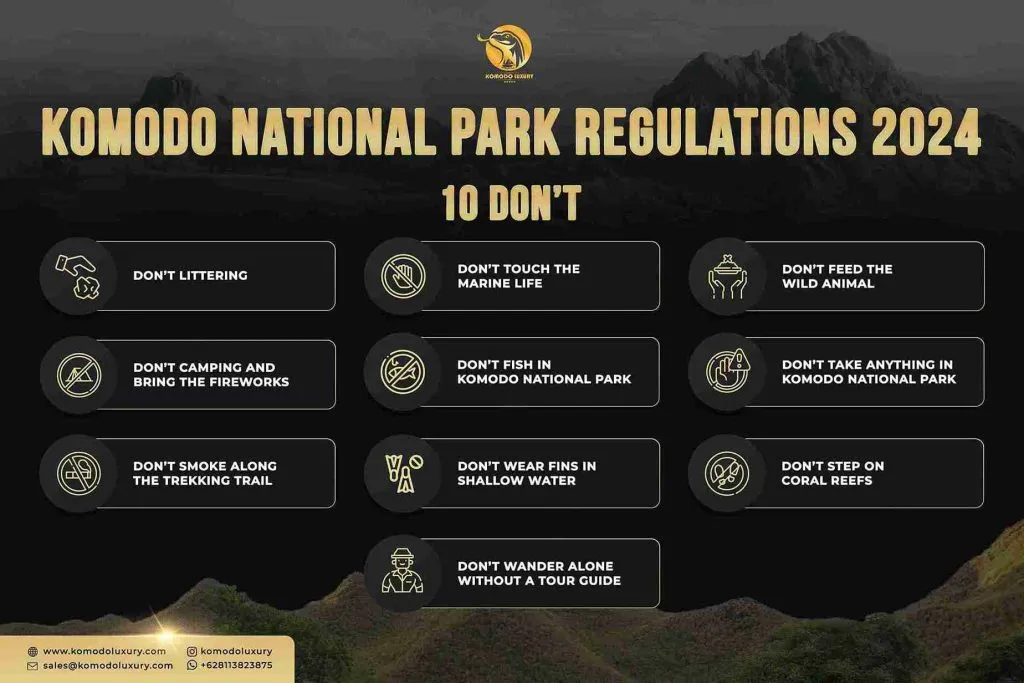
1. Don’t Littering
We all have a responsibility to keep Komodo National Park clean, so travelers should refrain from littering. There are no rubbish bins on each island. But travelers can bring their rubbish to be disposed of in the bins on board.
2. Don’t Touch the Marine Life
Komodo National Park is home to a wide variety of marine life. Including many types of coral reefs and hundreds of species of fish. In order to ensure the preservation and protection of the original habitat of marine life, visitors are required to follow the ‘no touching’ rule. Visitors are not allowed to touch marine life as this can cause stress, injury, or even death.
3. Don’t Feed the Wild Animal
Tourists are not allowed to feed wild animals, including Komodo dragons, horses, deer, wild boar, and other wildlife in the national park area. This is prohibited as it may alter the animals’ natural behavior in hunting prey and the animals’ habitat.
4. Don’t Camping and Bring the Fireworks
The Komodo National Park Office strictly prohibits travelers from camping, lighting campfires, and setting off fireworks around the National Park to protect the tranquility and safety of wildlife habitats, including Komodo dragons.
Travelers are not allowed to camp as the area is wild with free-roaming animals, making camping unsafe. Loud noises and bright lights, such as campfires and fireworks, can disturb wildlife and even subject them to behavioral changes and excessive stress, and even force them to leave their native habitats.
5. Don’t Fish in Komodo National Park
Komodo National Park is home to a variety of marine species, including some that are endangered, so the underwater ecosystem in this area is protected by the government. The no-fishing policy aims to maintain the balance of the marine ecosystem, protect marine life populations, and protect the ecosystem from damage caused by fishing activities.
6. Don’t Take Anything in Komodo National Park
Travelers are strictly prohibited from taking anything from the Komodo National Park, including sand, corals, plants, or animals, dead or alive, without written permission from the Head of the Komodo National Park. Taking anything in the National Park area is illegal and damages the habitat and conservation. If you insist on taking sand, corals, or protected animals. You will be subject to written sanctions up to and including imprisonment.
7. Don’t Smoke Along the Trekking Trail
There is a ban on smoking on trekking trails in Komodo National Park to maintain air quality and prevent forest fires caused by cigarette ash. Moreover, littering cigarette butts can contribute to pollution and harm wildlife in their natural habitats.
8. Don’t Wear Fins in Shallow Water
Fins are not recommended for snorkelers in shallow water areas of Komodo National Park. Such as the Kanawa and Manjarite Islands. This is to protect the fish and coral reefs, which are vulnerable to physical damage from fins. Fins are only permitted for experienced snorkelers.
9. Don’t Step on Coral Reefs
The waters of Komodo National Park are home to many beautiful coral reefs. Coral reefs are very vulnerable to marine life and play an important role in maintaining the balance of marine life. Touching or even stepping on coral reefs can cause serious damage to the reef structure and disrupt the ecosystem of marine life that depends on coral reefs. For this reason, tourists are expected to take care not to step on coral reefs when engaging in underwater activities in the National Park area.
10. Don’t Wander Alone without a Tour Guide
Visitors to Komodo National Park must be accompanied by a guide or ranger while exploring the Park. This policy is in place to ensure an informative experience, the safety of tourists, and the conservation of the environment.
Experienced guides are responsible for educating tourists about environmental ethics and national park rules to prevent damage to nature. In addition, local guides have exceptional knowledge of wildlife behavior, including Komodo dragons, which are dangerous wild animals.
Read More How to Travel to Komodo Island 2024 – Visit Komodo National Park
Conclusion
This complete guide by Komodo Luxury provides a comprehensive overview of the regulations of Komodo National Park and tips on preparing for the trip. It covers visitor guidelines, prohibited activities, and things to bring there. A key focus is responsible tourism and protecting the park’s unique ecosystem, home to the iconic Komodo dragon and other endangered species.
Visitors are encouraged to stay on designated paths, avoid disturbing wildlife, and dispose of waste properly. By following these regulations, tourists can contribute to the preservation and sustainability of Komodo National Park. This complete guide by Komodo Luxury serves as a valuable resource for visitors planning a trip to Komodo National Park, outlining the crucial rules that must be followed to ensure a harmonious and responsible experience in this extraordinary natural wonder.
If you want to explore more of Indonesia’s beautiful destinations, consider visiting Raja Ampat, known for its world-class diving, pristine marine life, and local cultures. Komodo Luxury offers customized tour packages to both Komodo National Park and Raja Ampat, allowing you to experience the best of Indonesia’s biodiversity and natural beauty. You can get information to learn more and start planning your trip here.
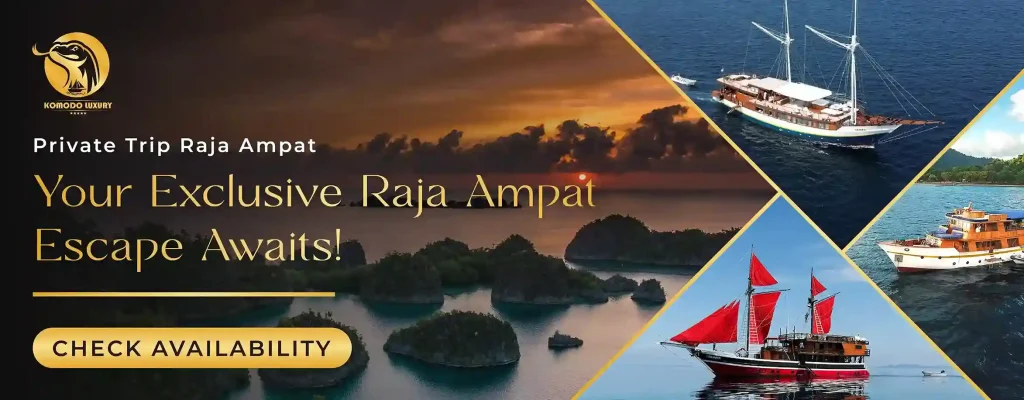
Check out for a glimpse of activities you can do on Komodo Island and Raja Ampat, get behind-the-scenes peeks, and keep up-to-date with paradise’s beautiful sights. Follow our Instagram @KomodoLuxury. Your journey begins here!
Frequently Asked Questions (FAQs) - Komodo Island Tour Packages
How much does it cost to Tour Packages in Komodo National Park?
The Tour Packages in Komodo National Park vary depending on the type of boat, facilities, and the duration of the rental. Please contact us to receive a customized price quote that aligns with your budget.
Is the Tour Packages price inclusive of the crew and guide?
Yes, the Tour Packages price includes the crew and guide. They will ensure the safety and enjoyment of your journey in Komodo National Park
What is the process of booking a boat in Komodo National Park?
The booking process is straightforward. You can contact us via Email or WhatsApp to check availability and discuss your journey details. Afterward, we will guide you through the booking process
Do I need to bring my own snorkeling or diving equipment?
We provide basic snorkeling equipment; however, if you have personal preferences or your own equipment, we recommend bringing them. Feel free to inquire about the necessary preparations before the trip for confirmation of available diving and snorkeling equipment.
Are Komodo National Park Tour Packages suitable for non-divers?
Absolutely! Our tour packages cater to both divers and non-divers. Non-divers can still enjoy the breathtaking scenery, engage in snorkeling activities, and explore islands and beaches of Komodo National Park during the trip
What are the sea conditions in Komodo National Park?
Due to the 3D2N trip sailing in the Komodo National Park, we navigate through bay waters, ensuring calm waves and currents.
Is it possible to depart on the same day as the trip?
For open trip departures, participants are expected to arrive at Komodo Airport by 09.00 am at the latest, as pick-ups will commence between 09.30 am and 10.30 am.
Private trips allow more flexibility, as the check-in time for private charter boats can be adjusted according to participants’ schedules. However, an earlier check-in is recommended to avoid time constraints at the destination.
Why stay overnight on the boat?
Komodo National Park trips are known for their natural beauty and underwater wonders, often requiring extensive travel. Staying on the boat allows participants to visit all destinations without rushing, providing a relaxed experience with booked cabin accommodations, eliminating the need for a hotel stay.
Is this trip safe for the elderly?
This trip is safe for older people, but please note that it involves a lot of physical activity, such as trekking, snorkeling, and diving. We advise the elderly who wish to take part in this trip to check their physical fitness and not force themselves to participate in strenuous activities.
Why are open trips held every weekend?
Open trips are scheduled on weekends to accommodate those who typically take time off during the weekend.
What is the difference between private and open trips?
Open trips allow individuals (1-4 people) to join a group with other participants. Private trips are recommended for groups of 5-30 people, providing the option to rent a private boat exclusively for the group.
Is fishing allowed in the Komodo national park area?
Fishing is prohibited in the Komodo National Park, as it is a protected area.
What is the difference between Rinca and Komodo Island?
Meeting Komodo Dragons on Komodo Island involves walking in the forest with close proximity to the dragons, guided by local guides and rangers.
Why is a copy of ID required for the trip?
A copy of ID (KTP/PASSPORT/SIM/ID CARD) is necessary for participant verification and safety data in case of unforeseen events. The data will be deleted after obtaining sailing clearance.
Is there a signal on the boat?
The signal on the boat may fluctuate, but users of the TSEL provider are likely to have a more stable connection.
Can electricity be used on the boat, and is a power bank needed?
Electricity on the boat operates 24/7. While power banks can be used for personal devices on the islands, the boat provides continuous electricity.
Can the trip be cancelled?
If there is a cancellation by the participant, then the payment that has been made cannot be refunded/moved trip/rescheduled, but the participant can find a replacement person (change name)
Cancellation due to Force Majeure (natural disasters, bad weather, riots, disease outbreaks, government regulations, and other coercive conditions), the trip can be changed/canceled, and there is no refund to participants for facilities that are not used or imposed any losses/inconvenience to the organizer.
(Force Majeure: an event that occurs beyond human ability and cannot be avoided so that an activity cannot be carried out properly).
Participants who arrive late at the meeting points so that they extend the itinerary from a specified time and inconvenience other participants, the late participants is deemed to resign and there is no refund
Is it possible to request a room for an open trip package?
Open trip travelers can request a room when booking to the admin, but it is adjusted to the condition and availability of the room.
Are there mosquitoes in Komodo National Park?
There are no mosquitoes in the sea, but there are mosquitoes around the pier and in Labuan Bajo.
Is there a supermarket in Komodo National Park?
There are no supermarkets or minimarkets in the Komodo National Park area. However, there are hawkers or small stalls in some tourist destinations, such as Komodo Island, Kelor Island, and Pink Beach.
